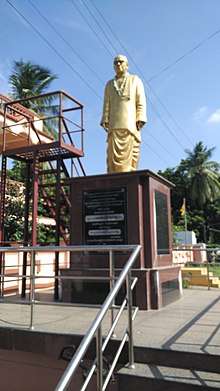Kakani Venkata Ratnam

Kakani Venkata Ratnam was a former Cabinet Minister in Andhra Pradesh in India.[1][2]
Life
He was born in Akunuru, Krishna district of Andhra Pradesh.. He was educated up to primary level at his native village Akunuru, further he has learned sanskrit and hindi languages through a tutor at neighbour village Kunderu. He has been attracted to the then freedom struggle moments started by Gandhiji. As a student youth leader he mobilised many youth to join the moment along with Pidikiti Madhava Rao, Rebala Buchi Ramaiah Shresty, Kalapala Surya Prakash Rao and Peta Brahmaiah to name few. They had worked day and night in organising a meeting at vijayawada in 1923 which was addressed by Gandhiji and later the place was named Gandhi Nagar municipal grounds. He has worked in support of khadi moment too. Mahatama Gandhiji also visited his native village Akunuru and that particular night he spent at Vuyyuru. Kakanai Venkata Ratnam has accompanied Gandhiji in covering the tour programme of Gandhiji which was stretched up to Mudunuru. Gradually he became a popular congress leader and lead as chairman of Krishna district congress committee for long duration.
He died of a heart attack on December 25, 1972 at the height of Jai Andhra movement.[3]
There is a statue commemorating him in the Benz circle of Vijayawada. There is also a library in his name in Vijayawada on Bandar road. There is also a marriage function hall in Hanuman Junction. His statues are present at Vizag and in Tanuku Andhra Sugar factory as well.
He was a great leader, who died of heart attack out of grieg of hearing the news of police firing of students who died in the Jai Andhra movement. His death was on the same day as India's ex president C. Rajagaoplachary. His death ceremony was performed with state rituals attended by the then Prime Minister and other national leaders.
References
- ↑ "Aspirants beware! Voters tilt the scales here". The Hindu. Chennai, India. March 16, 2004.
- ↑ ""Jai Andhra" now in momentum". AndhraCafe.com.
- ↑ Lucien D. Benichou, From Autocracy to Integration: Political Developments in Hyderabad State, 1938-1948 (Orient Longman, 2000), p. 282.